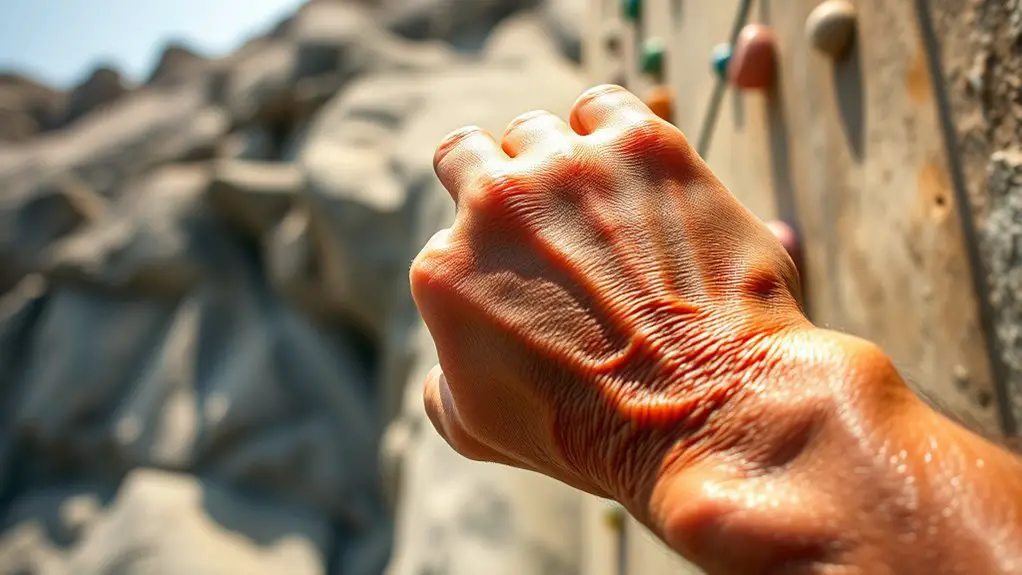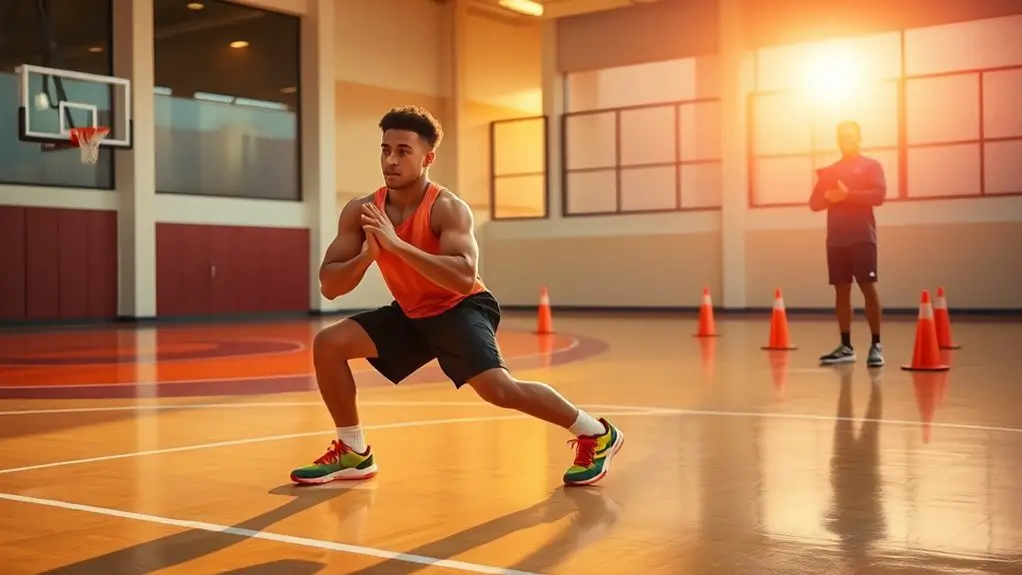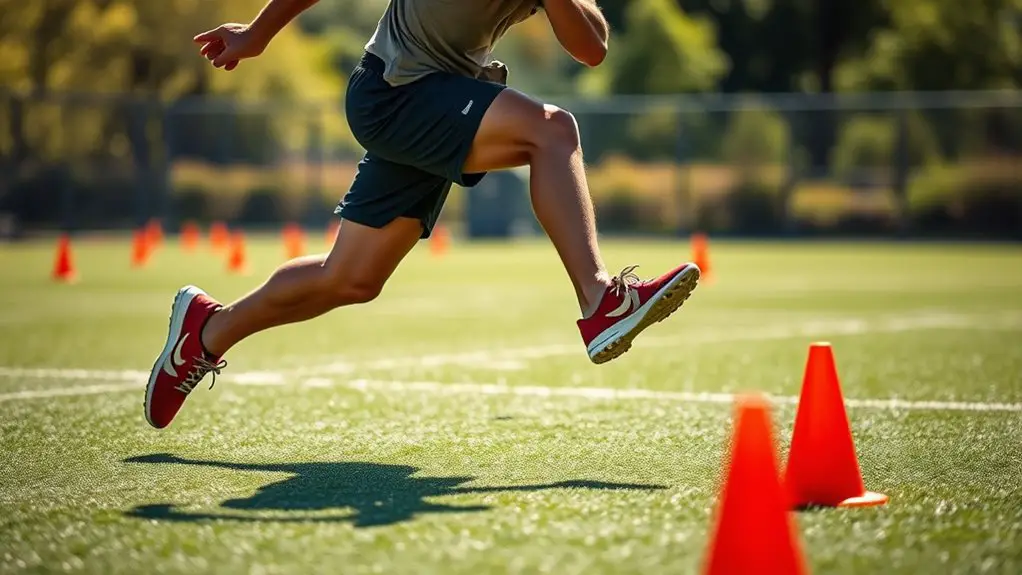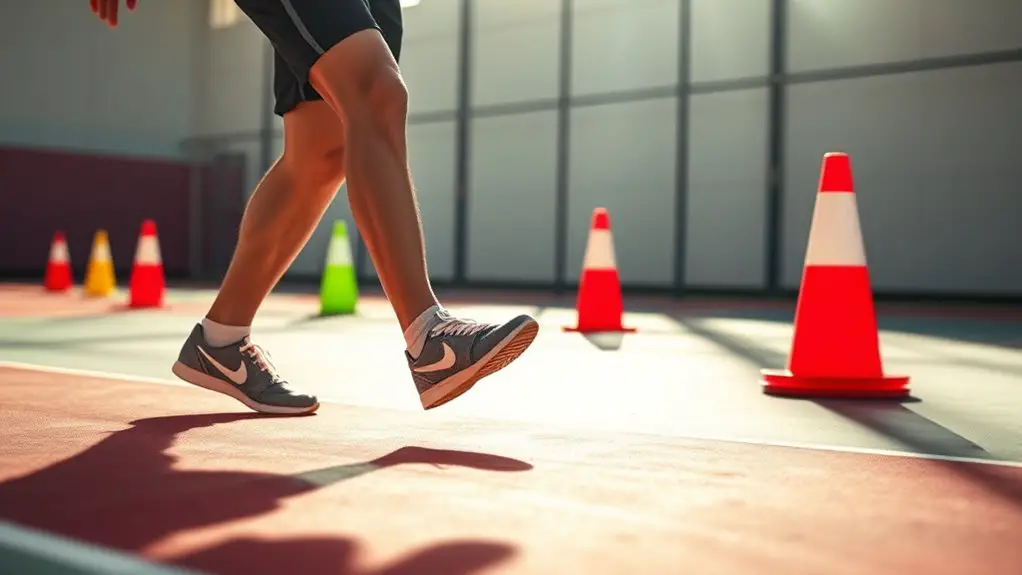To build grip strength for rock climbing, focus on various grip exercises like dead hangs, towel wringing, and fingerboard training. Incorporate grip strength tools and dynamic movements to challenge your hands and forearms effectively. Make sure you're also boosting your forearm strength with targeted exercises. It's essential to track your progress while adjusting your routine based on how your body feels. Keep practicing, and you'll discover more strategies to enhance your grip as you continue your climbing journey.
Understanding Grip Strength and Its Importance in Climbing
Grip strength is the backbone of successful rock climbing, acting as the essential link between you and the rock face. Understanding grip mechanics is crucial; it's not just about brute force but how you engage with holds. Strong grip mechanics allow you to maximize climbing performance, letting you tackle more challenging routes with confidence. You'll find that your hands aren't just tools—they become extensions of your will to ascend.
When you focus on building grip strength, you're releasing a sense of freedom on the wall. Whether you're scaling a boulder or a vertical route, a solid grip gives you the ability to explore heights that once seemed out of reach. With improved grip strength, your movements become more fluid, and you can hold onto those small edges that lead to exhilarating climbs. Hangboard training is an effective way to enhance finger strength, further propelling your climbing journey. Embrace the journey, and let your grip strength propel you toward the freedom of the climb.
Types of Grip Used in Rock Climbing
As you work on enhancing your grip strength, it's important to recognize the different types of grips you'll encounter on the rock face. Each grip offers a unique challenge and requires specific strength. The crimp grip is vital for holding onto tiny edges, while the open hand grip allows you to maintain control on larger holds. The pinch grip is significant for squeezing holds, and the sloper grip demands a strong, relaxed hand position.
When you find a jug hold, you can relax your grip, knowing you have a secure hold. The three finger grip is often used on small ledges, while the two finger drag helps you hang onto even the tiniest features. Don't forget the thumb catch, which can anchor your grip on slopers and pinches. Mastering these grips not only boosts your strength but also your confidence on the wall.
Essential Grip Strength Exercises
To build your grip strength effectively, incorporate a variety of essential exercises into your routine. Start with dynamic grip exercises like towel wringing or rope climbing; they'll challenge your grip in a fun and engaging way. Next, consider using grip strength tools such as hand grippers or stress balls. These tools can help you isolate and strengthen specific muscles in your hands and forearms.
Don't forget to add dead hangs to the mix—just hang from a pull-up bar for as long as you can. This simple exercise not only builds grip strength but also improves your endurance. Additionally, developing grip strength enhances overall health and physical fitness, providing a solid foundation for your climbing performance.
Lastly, try farmer's carries, where you walk while holding heavy weights in each hand. This combines grip strength with overall stability, giving you freedom in your movements. By varying your exercises and using tools, you'll notice significant improvements in your grip strength for climbing.
Incorporating Fingerboard Training
After establishing a solid foundation with various grip strength exercises, incorporating fingerboard training can take your climbing performance to the next level. Fingerboards offer an incredible opportunity to enhance your grip strength with targeted exercises. Start with basic holds, then explore fingerboard variations like slopers, pinches, and pockets to challenge yourself further.
To maximize your results, create a training schedule that balances fingerboard workouts with rest days, allowing your muscles to recover and adapt. Aim for two to three sessions per week, focusing on different grips and durations. Additionally, engaging in squats and deadlifts can improve your overall strength and stability, which is essential for effective climbing.
As you progress, don't hesitate to adjust the intensity and duration; listen to your body and verify you're not overdoing it. With consistent fingerboard training, you'll build the grip strength necessary for those challenging climbs, giving you the freedom to tackle more demanding routes with confidence. Embrace the journey, and let your grip do the talking!
The Role of Forearm Strength in Grip Development
Your forearm muscles are essential for developing grip strength, as they support your fingers during climbs. Without strong forearms, you'll struggle to hold onto grips and maintain endurance. Let's explore some effective exercises to boost your forearm strength and enhance your climbing performance. Incorporating exercises like wrist curls can significantly improve your grip strength by targeting the specific muscles used in climbing.
Importance of Forearm Muscles
While many climbers focus on finger strength, the significance of forearm muscles in grip development can't be overlooked. Your forearm anatomy plays an essential role in overall grip strength, as these muscles provide the endurance and power needed for sustained climbing. Strong forearms guarantee proper muscle activation during your climbs, allowing you to hold onto those challenging holds with confidence. Without well-developed forearm muscles, you might find yourself fatiguing quickly, limiting your ability to explore new routes or push your limits. Emphasizing forearm strength not only enhances your grip but also promotes better control and stability on the wall. So, if you're seeking that sense of freedom while climbing, don't underestimate the importance of building your forearm strength.
Exercises for Forearm Strength
To build impressive forearm strength, incorporating targeted exercises into your training routine is essential. Strong forearms not only enhance your grip but also empower your climbing ability. Here are four effective exercises to take into account:
- Forearm Curls: Using a barbell or dumbbells, perform curls to target the flexor muscles.
- Wrist Rollers: Attach a weight to a rope and roll it up and down to engage multiple muscles in your forearms.
- Towel Twists: Twist a towel to engage grip and forearm muscles dynamically.
- Dead Hangs: Hang from a pull-up bar for time to build endurance and strength.
Incorporate these exercises consistently, and you'll feel the freedom of improved grip strength on your climbs!
Using Climbing Holds for Grip Training
Using climbing holds for grip training is an effective way to build strength and improve your performance on the rock face. By incorporating various hold types—like crimps, slopers, and pinches—into your training routines, you can target different muscle groups and enhance your grip. Start by using a hangboard or a climbing wall with diverse holds. You can practice dead hangs, where you hang from a hold for a set duration, or even do pull-ups on different holds to build strength dynamically.
Mixing up your routine keeps things fresh and challenges your grip in new ways. Additionally, incorporating exercises like Farmers Walk can further enhance your grip strength. Don't forget to incorporate rest days, allowing your muscles to recover and grow. Finding the right balance between intensity and recovery is key to revealing your climbing potential. Embrace the freedom that comes with strong grip strength, and watch as your climbing skills soar!
Improving Grip Endurance
Building grip endurance is essential for tackling longer climbs and more challenging routes. As you push your limits, you'll inevitably face grip fatigue, so incorporating endurance training into your routine is vital. Here are four effective strategies to improve your grip endurance:
- Hang Board Training: Use a hangboard to practice hanging for extended periods. Start with shorter intervals and gradually increase the duration.
- Weighted Pull-Ups: Add weight to your pull-ups to build overall strength and endurance in your grip.
- Farmers Walks: Carry heavy weights over a distance to enhance grip strength and endurance simultaneously.
- Static Holds: Find a challenging hold and maintain your grip for as long as possible. This will help your muscles adapt to prolonged tension.
Climbing Techniques to Enhance Grip
After developing grip endurance, refining your climbing techniques can greatly enhance your grip performance on the wall. One way to achieve this is by practicing dynamic grip techniques, which involve using momentum to shift between holds. This not only conserves energy but also maximizes your grip's effectiveness. Focus on maintaining tension in your arms and core as you move, ensuring you're always ready to catch the next hold.
Additionally, explore advanced hold strategies, like the use of open-hand grips on slopers or pinches. This helps you adapt to different climbing scenarios and strengthens your fingers in various positions. Remember to visualize the movement and anticipate your next hold, as this mental preparation can improve your overall fluidity and grip efficiency. By integrating these techniques into your climbing sessions, you'll not only enhance your grip but also gain a greater sense of freedom on the rock face.
Nutrition and Recovery for Grip Strength
While you may focus on training your muscles for grip strength, nutrition and recovery play essential roles in supporting your progress. To enhance your grip strength gains, consider these nutrition strategies and recovery techniques:
- Protein Intake: Make sure you consume enough protein to aid muscle repair and growth. Aim for lean sources like chicken, fish, or plant-based options.
- Hydration: Stay hydrated to maintain peak muscle function and prevent cramps during training sessions.
- Fruits and Veggies: Incorporate a variety of colorful fruits and vegetables for antioxidants, which help reduce inflammation and promote recovery.
- Post-Workout Snacks: Refuel with a balanced snack that combines carbs and protein within 30 minutes after training to kickstart recovery. Adequate protein intake is crucial for reducing soreness and accelerating recovery time.
Tracking Your Progress and Setting Goals
To effectively improve your grip strength for rock climbing, tracking your progress and setting clear goals is essential. It keeps you motivated and gives you a sense of freedom as you see real improvement. Start by establishing specific, measurable goals, and then regularly evaluate your progress to stay on track. Incorporating rest days into your training routine is crucial for ensuring that your grip strength improves without the risk of overtraining.
Here's a simple goal tracking table to help you monitor your progress:
| Date | Goal | Progress Evaluation | Notes |
|---|---|---|---|
| 2023-10-01 | 30-second hang | 25 seconds | Felt strong but shaky |
| 2023-10-15 | 35-second hang | 30 seconds | Improved grip technique |
| 2023-10-30 | 40-second hang | 38 seconds | Need more endurance |
| 2023-11-15 | 45-second hang | 42 seconds | Great improvement |
Frequently Asked Questions
How Long Does It Take to See Grip Strength Improvements?
When you're working on grip strength, you might wonder how long it'll take to see improvements. Typically, you can start noticing changes within a few weeks, but it really depends on your training frequency and consistency. Keeping track of your progress can help you stay motivated and make adjustments as needed. Remember, the more you train, the quicker you'll feel that newfound freedom in your grip, opening up new possibilities for adventure!
Can Grip Strength Training Prevent Climbing Injuries?
Yes, grip strength training can definitely aid in injury prevention. By focusing on your grip, you're not just improving your performance; you're also reinforcing the muscles and tendons that support your hands and arms. Plus, training consistency is key. The more regularly you train, the stronger and more resilient you'll become, allowing you to embrace the freedom of climbing without the fear of injuries. So, commit to your practice, and enjoy your ascents!
What Are Common Mistakes in Grip Strength Training?
When it comes to grip strength training, don't bite off more than you can chew. Common mistakes include neglecting proper technique, which can lead to ineffective workouts or even injuries. Many people also fall into the trap of overtraining, risking burnout and setbacks. To truly feel free in your training, focus on consistent, mindful practice instead of pushing too hard too fast. Remember, quality trumps quantity every time!
Is There an Ideal Age to Start Grip Training?
There isn't a strict ideal age to start grip training, but age considerations do play a role. Starting young can help you develop strength and coordination, while older individuals may benefit from training to maintain functionality. The training benefits are clear: improved grip strength enhances performance in various activities. Ultimately, it's about finding the right balance for your body and enjoying the freedom that comes with increased strength at any age.
How Does Body Weight Affect Grip Strength?
Body weight plays a significant role in grip mechanics. The more body weight you carry, the greater the demand on your grip strength during activities. If you're lighter, you might find it easier to maintain grip, but don't underestimate the strength training needed to support that weight. Balancing your body weight with targeted exercises can enhance your grip, giving you the freedom to tackle challenges more efficiently and confidently. Explore what works best for you!




